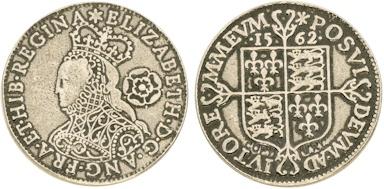Elizabethan Money
In the England of Elizabeth, money was not an abstract concept. All coins were made of either gold or silver (not copper and certainly not paper) and a coin was worth what its constituent metals were worth.
 For this reason, any foreign coin was also current in England, and the exchange rate was based upon the amount of specie it contained relative to an English coin.
For this reason, any foreign coin was also current in England, and the exchange rate was based upon the amount of specie it contained relative to an English coin.
The English system was based upon the "Pound, Shilling, Pence" system. Twelve Pence made one Shilling and twenty Shillings made up one Pound. These values were constant and never varied in relation to each other. The exact value of other coins might vary however. Sovereigns, Nobles, Angels, Testoons and Royals all had values that fluctuated depending on their weight and purity at their most recent minting. The values given are those for about 1580. It should be mentioned however, that in the public mind, gold was always more valuable than its monetary equivalent in silver. Therefore, gold tended to be hoarded while silver circulated; and when gold was spent, a seller would often be willing to accept a lower price if payment was in gold.
If a fractional coin is mentioned below a coin's name, that means that there was a coin minted that's value was tied to the value of a parent coin (e.g. a Half-Angel was always worth half the current value of an Angel).
Note: "£" is the symbol for Pound, "s" for Shilling and "d" for Penny.
Monies of Account
The "Money of Account" was a book keeper's convention, which was not represented by an actual coin. Until 1583, the Pound was a Money of Account. A "Pound" coin was minted in that year for the first time.
Mark (13s 4d)
The Mark was equivalent to 160d. It was primarily used in high level transactions such as buying or selling land or assessing substantial fines.
Gold Coins
- Sovereign (20s)
For most of the reign, the Sovereign was the Pound coin. When the Pound coin was issued, a 30s "Fine" Sovereign was minted. Also Half-Sovereign - Pound (20s)
Also Half-Pound. - Royal (11s 3d)
Not minted since Mary's time but still in circulation. Also spelled "Ryal" or "Rial" - Angel (10s)
Also Half-Angel and Quarter-Angel - Noble (6s 8d)
An old coin from the time of Henry VIII, but still in circulation - Crown (5s)
The smallest gold coin. It was also issued as a silver coin of the same value. Also Half-Crown
Silver Coins
- Shilling (12d)
- Sixpence (6d)
- Groat (4d)
- Thruppence (3d)
- Testoon (2 1/4d)
Also called "Tester". An old coin of Henry VIII still in circulation - Tuppence (2d)
Also half-groat - Three-Half-Penny (1 1/2d)
- Penny (1d)
The plural is, of course, pence. - Three-farthing (3/4 d)
- Half-penny (1/2 d)
Also Haypenny - Farthing (1/4 d)
There was no Elizabethan Farthing coin. A coin worth a Farthing would be too small to be practical.
